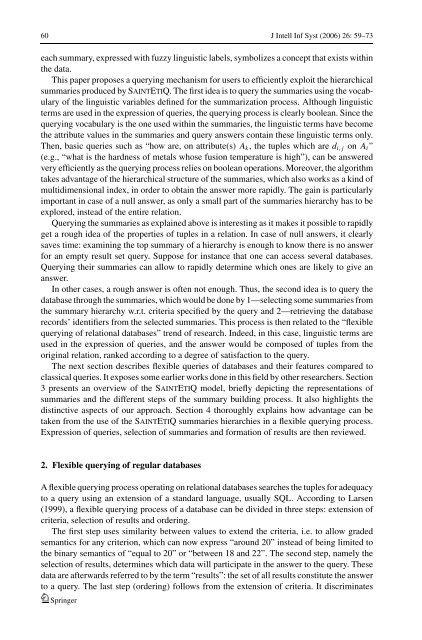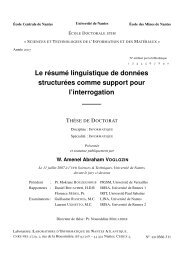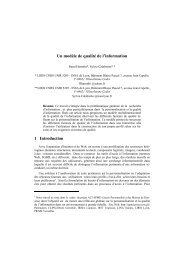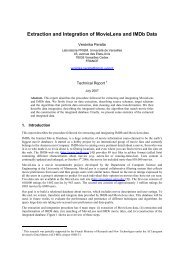You also want an ePaper? Increase the reach of your titles
YUMPU automatically turns print PDFs into web optimized ePapers that Google loves.
60 J Intell Inf Syst (2006) 26: 59–73each <strong>summary</strong>, expressed with fuzzy linguistic labels, symbolizes a concept that exists withinthe data.This paper proposes a querying mechanism for users to efficiently exploit the hierarchicalsummaries produced by SAINTETIQ. The first idea is to query the summaries using the vocabulary<strong>of</strong> the linguistic variables defined for the summarization process. Although linguisticterms are used in the expression <strong>of</strong> queries, the querying process is clearly boolean. Since thequerying vocabulary is the one used within the summaries, the linguistic terms have becomethe attribute values in the summaries and query answers contain these linguistic terms only.Then, basic queries such as “how are, on attribute(s) A k , the tuples which are d i, j on A i ”(e.g., “what is the hardness <strong>of</strong> metals whose fusion temperature is high”), can be answeredvery efficiently as the querying process relies on boolean operations. Moreover, the algorithmtakes advantage <strong>of</strong> the hierarchical structure <strong>of</strong> the summaries, which also works as a kind <strong>of</strong>multidimensional index, in order to obtain the answer more rapidly. The gain is particularlyimportant in case <strong>of</strong> a null answer, as only a small part <strong>of</strong> the summaries hierarchy has to beexplored, instead <strong>of</strong> the entire relation.<strong>Querying</strong> the summaries as explained above is interesting as it makes it possible to rapidlyget a rough idea <strong>of</strong> the properties <strong>of</strong> tuples in a relation. In case <strong>of</strong> null answers, it clearlysaves time: examining the top <strong>summary</strong> <strong>of</strong> a hierarchy is enough to know there is no answerfor an empty result set query. Suppose for instance that one can access several <strong>database</strong>s.<strong>Querying</strong> their summaries can allow to rapidly determine which ones are likely to give ananswer.In other cases, a rough answer is <strong>of</strong>ten not enough. Thus, the second idea is to query the<strong>database</strong> through the summaries, which would be done by 1—selecting some summaries fromthe <strong>summary</strong> hierarchy w.r.t. criteria specified by the query and 2—retrieving the <strong>database</strong>records’ identifiers from the selected summaries. This process is then related to the “flexiblequerying <strong>of</strong> relational <strong>database</strong>s” trend <strong>of</strong> research. Indeed, in this case, linguistic terms areused in the expression <strong>of</strong> queries, and the answer would be composed <strong>of</strong> tuples from theoriginal relation, ranked according to a degree <strong>of</strong> satisfaction to the query.The next section describes flexible queries <strong>of</strong> <strong>database</strong>s and their features compared toclassical queries. It exposes some earlier works done in this field by other researchers. Section3 presents an overview <strong>of</strong> the SAINTETIQ model, briefly depicting the representations <strong>of</strong>summaries and the different steps <strong>of</strong> the <strong>summary</strong> building process. It also highlights thedistinctive aspects <strong>of</strong> our approach. Section 4 thoroughly explains how advantage can betaken from the use <strong>of</strong> the SAINTETIQ summaries hierarchies in a flexible querying process.Expression <strong>of</strong> queries, selection <strong>of</strong> summaries and formation <strong>of</strong> results are then reviewed.2. Flexible querying <strong>of</strong> regular <strong>database</strong>sA flexible querying process operating on relational <strong>database</strong>s searches the tuples for adequacyto a query using an extension <strong>of</strong> a standard language, usually SQL. According to Larsen(1999), a flexible querying process <strong>of</strong> a <strong>database</strong> can be divided in three steps: extension <strong>of</strong>criteria, selection <strong>of</strong> results and ordering.The first step uses similarity between values to extend the criteria, i.e. to allow gradedsemantics for any criterion, which can now express “around 20” instead <strong>of</strong> being limited tothe binary semantics <strong>of</strong> “equal to 20” or “between 18 and 22”. The second step, namely theselection <strong>of</strong> results, determines which data will participate in the answer to the query. Thesedata are afterwards referred to by the term “results”: the set <strong>of</strong> all results constitute the answerto a query. The last step (ordering) follows from the extension <strong>of</strong> criteria. It discriminatesSpringer







